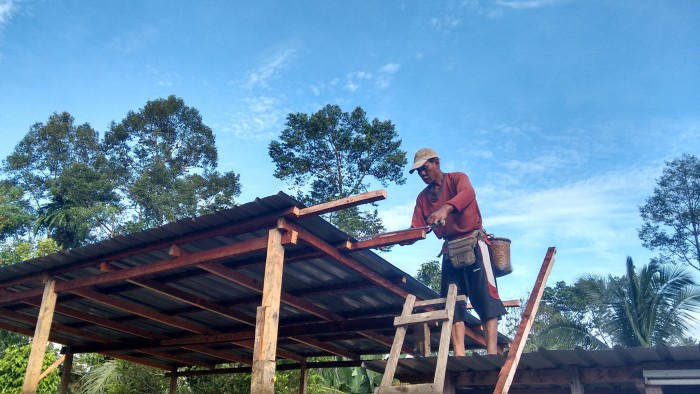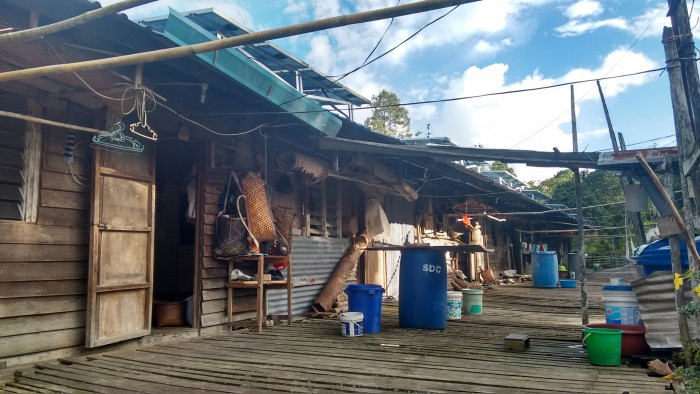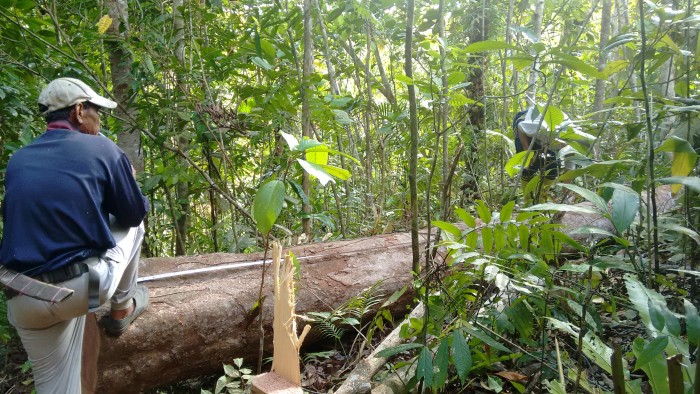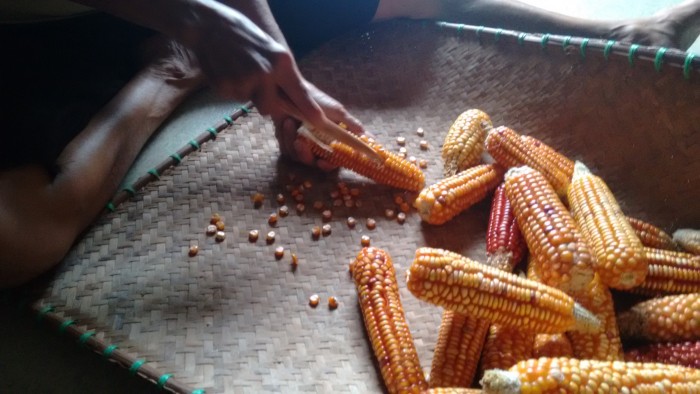The orang solar (“solar men”) are finally here. The longhouse community has been lit in a pleasant buzz since awaiting the arrival of the technicians (described by my adoptive parents, as “orang solar”) who would install new solar panels. The week prior, the available men in the longhouse had worked every day on building the shed that would house the solar batteries within and the solar panels above.

Apai1 tells me that the solar batteries are arriving separately from Germany. He is so impressed with the origin of the batteries that he repeats this fact to me a couple of times. However, he worries, they might be delayed in the port, not in time for Christmas when the villagers’ adult children return for the holidays from working in the cities.
The solar panels are not the first that the village has had. The first sixteen solar panels were placed above the longhouse roof about a year ago, replacing the many village generators run on diesel. However, the electricity generated from the solar panels is enough for “lights and TV only”—not enough to run the iceboxes or a washing machine that sits idle in a bathroom where I bathe with a scoop and a bucket.

I’ve been conducting ethnographic research in this Iban village of Batang Ai that sits close to the Sarawak/Kalimantan border for about a couple of months so far. Broadly, I am interested in the different ways indigenous rural communities in Sarawak, Malaysian Borneo, assert their rights over territorial domains that may lead to successful conservation of forests. It’s been full cycle returning to Batang Ai, where I had previously worked as a wildlife researcher for an international conservation NGO about ten years ago.
No longer counting orang utan nests in a strictly quantitative study whereby the forested landscapes are our dwellings for long periods of time and longhouse communities are a mere night’s stopover to obtain local field assistants, I am returning as a DPhil student, in a comparatively “messy” ethnographic study to examine the political ecology and the differing social-cultural interpretations of conservation landscapes in Sarawak.
I struggle with many things, including learning Iban, which everyone says should be easy for me to learn because it closely resembles Malay, the national language of Malaysia. My slowness in learning the language reminds me of how knowing Malay and some Iban was good enough as a wildlife researcher conducting nest count surveys.
“Bisik medak sarang maias?” Can you see an orang utan nest?
“Anang guai!” Slow down!
“Ako lelah.” I’m tired.
Local communities are more or less removed from the “realities” of wildlife research, unless the men (and usually, only men) are needed as field assistants or when conservation education workshops are conducted, with the assumption that indigenous rural communities are not conservationists or if they have any conservation knowledge, this has been forgotten and must be revived.
Years later, I have returned to Batang Ai, with a humbler approach and a willingness to accept my ignorance on many local issues. I no longer preach conservation when the local hunter comes by with kijang (barking deer) meat to sell. I try to understand why certain wildlife meat is preferable, why other wildlife remains a local taboo, and why sometimes local conservation strategies fail to work. I ask a lot of questions about how they manage different parts of their land or why certain forests are kept aside instead of being converted to rice fields. I learn the Iban terms for different stages of managed forest succession and the rituals that go along with it. During the grueling month of September, when the Indonesian haze was at its peak, I planted rice with two communities, and throughout the later months, I help harvest their intermittent crops. Unlike my time as a wildlife conservationist, I now spend more time with rural women, and in doing so, I learn about their dreams, hopes, and their hidden labor.
A few days before the arrival of the solar men, I watched my adoptive father and several men cut down a tree that was over thirty years old. With the aid of a hand chainsaw, the tree fell within less than ten minutes. It was then sawed into planks that would be used as walls for the solar shed. From seed to mighty tree to now, wood to build a solar shed.

I felt really sad to watch how quickly the tree fell after many decades of growth. But I stayed silent. Part of the agreement for accepting the solar panel donation includes that the community would have to provide the wood and labor for the solar shed. The additional solar panels are appreciated by the community members, who have seen many of their adult children leaving for work opportunities elsewhere. “We can have cold water and keep meat that we don’t preserve from spoiling,” says Apai. “Our grandchildren [who live in the towns with their parents] are not used to our food and prefer fried chicken wings and cold drinks.”
Much of the rural community life is changing, as most of the younger generation have opted for non-farming jobs and town lifestyles. However, this particular community has managed to retain its customary ways and customs, weaving into what I am beginning to understand as part of its multiple strategies to maintain rights over land and forests and to entice villagers’ adult children and grandchildren to eventually return home one day and help maintain intergenerational territorial rights.

Apai explains further that after a couple of decades of living without being tapped into the main electricity grid, which derives part of its energy from the Batang Ai dam,2 he decided that he had enough and asked for a solution from the government agency responsible for building many dams in the state. He wasn’t thinking of solar energy at that time, but he felt it wasn’t fair that some people in the state were benefiting from the dam-generated electricity, while others, living within the dam site itself, had to rely on diesel-run generators.
A year later, the government agency announced that it was donating solar panels to the community. “It’s been good so far,” Apai says. “We no longer spend about RM300 [about 50 pounds] per family per month to keep the generator going.” I keep to myself, my suspicions of the giver’s intent, particularly the timing of the second solar panel donation, so close to approaching state elections. After all, the community members clearly feel that they have benefited from this contribution. I also ask myself, would I do the same if I were in their place and seek for support wherever I could find it?
I am pleasantly surprised that despite the availability of the 24-hour electricity generated by solar energy, the community has so far maintained its relative independence from electricity. TV viewing, for example, is kept for a couple of hours during the night, after dinner. The community is close knit, and the young people and children who return home for the weekend or holidays, spend more time in the ruai,3 as their parents did when they were their age.
I remember many of the pleasurable afternoons when there was no work to be done in the rice fields: together, sitting cross-legged in the ruai, we, three generations of women, are peeling corn kernels off by hand, from the cobs that have been dried in the hot sun the day before. Unfamiliar with the work, I quickly shred my thumb until it bleeds an angry red, similar to the bronzed color of the corn. Sometimes, when the noon is relentlessly hot and we have just finished our meal, we spread out on our backs on the ruai to nap until the air becomes bearable. There is an option of switching on the fan, yet people prefer to lie close to the open doors, where there is more of a breeze. I particularly enjoy the late afternoon lazy conversations that occur on the ruai, snacking on fruit or tubers sourced from around the longhouse and the rice fields.

The month of December has brought in the coveted durian season, and we have been feasting on the creamy custard flesh every day. When our stomachs groan with the weight of durian and we can no longer eat any more, what is left is mashed into tempoyak4. Like sunrays converted into solar energy, durian is converted into another desired source of energy.
One evening, under the glare of the television light powered by solar, my adoptive parents prepare a monthly ritual to give thanks to the gods for their eldest son’s new job in the oil and gas industry. Apai waves a chicken egg above the plate offering of seven ritual ingredients that includes rice wine. Later, he would pour the rice wine between the cracks of the wooden floor. He conducts this ritual in what appears to be in a perfunctory manner, as his eyes drift to the TV when the short ritual ends. Apai reminds me later that it is important to remember your roots, where you come from, despite how far you may have traveled. This includes what travels toward you, including the solar panels and solar batteries from Germany.
“We came from the earth, we return to the earth,” says Apai, who expresses hope that his children would one day, return to the longhouse, to help protect their land and forests. “It is their pusaka,5” he adds.
Solar energy may have brought some convenience to the community, such as freeing up limited financial resources. However, it seems that the maintenance of traditional customs and ways is dependent on the elders who feel the need for it and thus express this need through mostly actions. The younger people then learn from observing and may emulate their parents, while adapting to their own current needs and wishes.
The solar men have arrived, and I am roped in, as the adoptive daughter, to help prepare food for lunch. They are local men from the nearby town and easily converse in Iban with the community. They would later spend the next couple of days hammering the solar panels into place, as the community watches. As Apai has feared, the solar batteries are stuck in port and will likely be released after the New Year.
“Not in time for Christmas,” he frets, anticipating visits from his six children and eleven grandchildren. And then he smiles, “It is good to have solar [energy]; life is a little better now.”
June Rubis is a DPhil candidate in the School of Geography and Environment at the University of Oxford. Her dissertation explores the different strategies and politics of how conservation landscapes are made in Sarawak, Malaysian Borneo.
All photos in this post are credited to this author.
1. Meaning “father” in Iban. Apai is my adoptive father in the community and also the longhouse headman.
2. Batang Ai dam was completed in 1985 and displaced about 3,000 people from twenty-six longhouses (Aiken and Leigh 2015). This particular longhouse community was not displaced, as they were living further inland, close to the Indonesian-Sarawak border. The village moved closer to the dam site in the early 1990s.
3. communal corridor
4. preserved durian
5. Meaning “heritage” in Iban and Malay; its origin is derived from Sanskrit
Reference
Aiken, S. Robert, and Colin H. Leigh. 2015. Dams and Indigenous Peoples in Malaysia: Development, Displacement and Resettlement. Geografiska Annaler: Series B, Human Geography 97, no. 1: 69–93.
Cite as: Rubis, June. 2016. “Solar, Sustainability, and Strategies in Sarawak.” EnviroSociety. 3 February. www.envirosociety.org/2016/02/solar-sustainability-and-strategies-in-sarawak.
